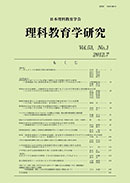Volume 42, Issue 2
Displaying 1-6 of 6 articles from this issue
- |<
- <
- 1
- >
- >|
Original Papers
-
2002 Volume 42 Issue 2 Pages 1-12
Published: March 29, 2002
Released on J-STAGE: June 30, 2022
Download PDF (1731K) -
2002 Volume 42 Issue 2 Pages 13-23
Published: March 29, 2002
Released on J-STAGE: June 30, 2022
Download PDF (1965K)
Note
-
2002 Volume 42 Issue 2 Pages 25-34
Published: March 29, 2002
Released on J-STAGE: June 30, 2022
Download PDF (1329K) -
2002 Volume 42 Issue 2 Pages 35-42
Published: March 29, 2002
Released on J-STAGE: June 30, 2022
Download PDF (990K) -
2002 Volume 42 Issue 2 Pages 43-50
Published: March 29, 2002
Released on J-STAGE: June 30, 2022
Download PDF (1198K) -
2002 Volume 42 Issue 2 Pages 51-61
Published: March 29, 2002
Released on J-STAGE: June 30, 2022
Download PDF (1575K)
- |<
- <
- 1
- >
- >|
